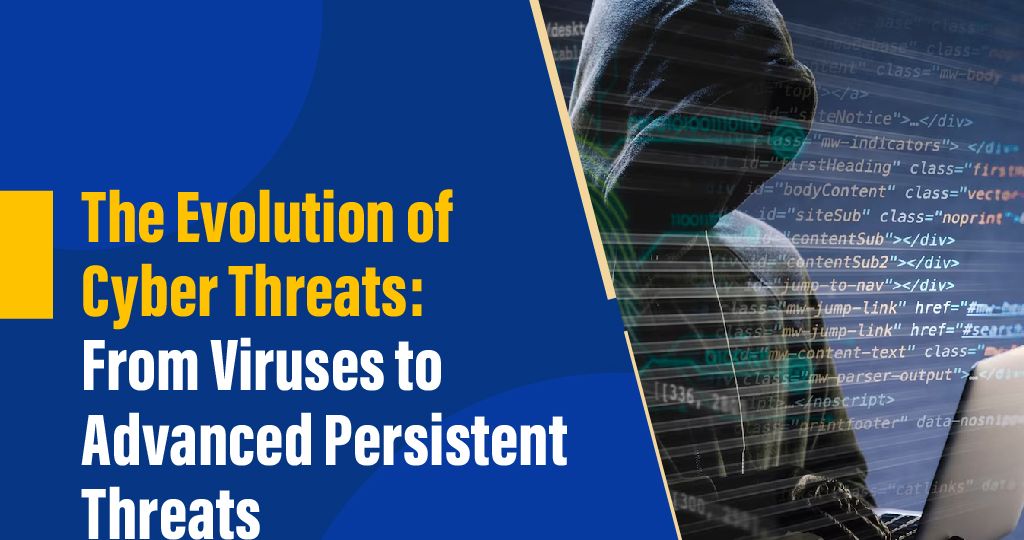
Introduction
Over the decades, digital reality has seen the growth of cyber threats at a tremendous rate. What initially were simple viruses that caused chaos to basic systems have now morphed into an intricate web of menacing cyber tactics engineered, often with precise precision, to be dangerous for the enterprises, governments, and individuals navigating this vast technological expanse.
Let us trace this development, from viruses to APTs (Advanced Persistent Threats), so we can gain a complete understanding of its depth and implications.
The Digital Renaissance and Cybersecurity Awakening
Digital technologies have revolutionized connectivity between people, commerce, and data exchange. Yet, with this boundless expansion arose vulnerabilities that cybercriminals eagerly exploited. At first, cybersecurity was often only an afterthought during digitization’s early phases, but with personal and company data now increasingly stored online, data protection became an imperative necessity.
The Ascension of Cyber Threats as Global Anxieties
Cyber threats quickly evolved from financial fraud to clandestine espionage into an urgent global menace. Data, often considered a modern currency, quickly became highly valued assets as malicious entities devised sophisticated schemes for its exploitation.
The Dawn of Cyber Intrusions
- The Genesis of Computer Viruses: The late 1980s marked an explosion of computer viruses – digital parasites capable of self-replication that spread via floppy disk, most famously “Brain”, targeting MS-DOS systems in 1986 and causing unprecedented cyber disruption.
- The Surge of Malware in the 1990s: With the proliferation of Internet technology came malware proliferation. Malware quickly took advantage of this and thrived rapidly. Social engineering techniques fueled the spread of viruses like “Melissa” and “I Love You,” which preyed on user naivety to inflict data breaches and widespread havoc.
Evolution of Worms and Trojans: A New Threat Paradigm
Worms: Autonomous Agents of Chaos
Worms distinguished themselves from viruses by replicating without user involvement and taking advantage of system vulnerabilities to gain entry to networks. One particularly infamous worm was 1988’s Morris Worm, which showed its deadly potential.
Trojans: Digital Deceivers
Trojans, commonly disguised as innocent software programs, allow hackers to gain unwary entry to compromised computer systems through stealth methods. Their prevalence skyrocketed during the early 2000s due to email attachments or seemingly innocent downloads that contained Trojans.
Spyware and Adware: The Silent Intruders
Spyware’s Clandestine Rise
Spyware was introduced into society during the early 2000s to stealthily collect personal data without detection from users, track user behaviors, and intercept passwords in an effort to gather personal information without detection by security services.
Adware: A Gateway to Greater Malice
Adware was traditionally associated with unwanted ads; however, its presence often provided cover for more dangerous threats like spyware and ransomware to enter computers, creating additional cybersecurity hazards for its victims.
The Human Factor: Phishing and Social Engineering
Phishing: Digital Deception Personified
Phishing exploits human psychology to extract sensitive information under the guise of legitimacy. Initially targeting financial scams, phishing attacks have evolved to encompass spear phishing, which tailors fraudulent communications to individual targets for increased efficacy.
The Art of Psychological Exploitation
Phishing’s effectiveness lies in its manipulation of human emotions such as urgency, fear and curiosity. By exploiting victims’ psychological vulnerabilities to set elaborate traps for them to fall into, attackers have an effective tool at their disposal for targeting individuals in intricate schemes.
Ransomware: The Age of Digital Extortion
Ransomware’s Global Onslaught
Ransomware emerged as an increasingly dangerous threat during the 2010s, encrypting users’ files and demanding payment in return for its release – global attacks like 2017’s WannaCry attack were prime examples of its devastation and destruction.
Mechanics of Ransomware Attacks
Typically, employing phishing schemes or exploiting unpatched software, ransomware encrypts data, rendering it inaccessible until attackers receive their demanded ransom—often in cryptocurrency.
Advanced Persistent Threats: Cyber Espionage Redefined
Deciphering APTs
APTs represent stealth and sophistication in cybersecurity. Typically, state-sponsored, APT campaigns infiltrate systems to exfiltrate sensitive data over an extended period, remaining undetected until significant damage has been done to systems.
Prominent APT Incidents
From the “Stuxnet” worm targeting Iran’s nuclear facilities in 2010 to the 2017 Equifax breach, APTs underscore the geopolitical dimensions of cyber warfare.
Nation-State Cyber Warfare: The Digital Battlefield
Cyberattacks as Instruments of Power
Amid escalating geopolitical tensions, nations deploy cyber assaults as strategic tools to disrupt adversaries’ economies, critical infrastructure, and information ecosystems.
Illustrative Nation-State Attacks
The 2007 cyberattack on Estonia crippled governmental functions, while the SolarWinds breach of 2020 exemplified the vulnerability of even sophisticated systems to state-sponsored infiltration.
Emerging Cyber Threats: AI and Quantum Frontiers
AI: Double-Edged Sword of Cybersecurity
While AI amplifies threat detection and response, it also enables attackers to create adaptive, resilient malware, further fueling the endless cybersecurity arms race.
Quantum Computing’s Looming Threat
Quantum technology may be revolutionary, yet its implementation poses significant risks to existing encryption standards and could expose vast swaths of digital infrastructure to cyber threats.
Counteracting Cyber Threats
Personal Cyber Hygiene
Individuals need to adopt stringent security practices such as strong passwords, two-factor authentication, regular software updates and regular backups while increasing phishing awareness to best defend themselves.
Enterprise-Level Strategies
Organizations require comprehensive protection measures such as firewalls, intrusion detection systems and employee training courses in order to remain safe from cybercrime. Periodic vulnerability assessments and incident response protocols ensure you remain ready to face evolving threats.
Conclusion
As viruses have evolved into sophisticated APTs, cyber threats continue to evolve with them. Cyber warfare becomes ever more complex while AI, quantum computing, and global strategies shape cybersecurity’s future. Addressing these challenges requires innovation, collaboration, and an unwavering commitment to resilience.
